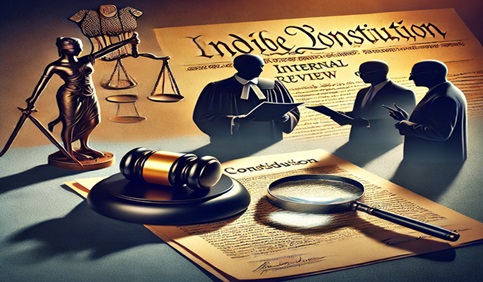Prelims: Internal enquiry against Justice
Mains: Structure, organisation and functions of the executive and the judiciary- ministries and departments of the government, influential groups and formal/informal associations and their role in the system of governance. |
Why in the NEWS?
- Chief Justice of India (CJI) Sanjiv Khanna has constituted a three-member committee to inquire into allegations of recovery of huge sums of cash following a fire at the official residence of Justice Yashwant Verma of the Delhi High Court.

Key Points:
- The allegations against Justice Yashwant Verma of the Delhi High Court will be probed by a three-member committee.
- The procedure for such an inquiry was laid down by a panel appointed by the Supreme Court three decades ago, and revisited by the apex court in 2014.
- The judiciary's internal probe which follows a different procedure from impeachment under the Constitution will be conducted by
- Justice Sheel Nagu, Chief Justice of Punjab and Haryana High Court,
- Justice G S Sandhawalia, Chief Justice of Himachal Pradesh High Court and
- Justice Anu Sivaraman of Karnataka High Court.
What will you read next in this topic?
- What is the procedure for impeachment of a Judge?
- Internal Inquiry Process of Judiciary
- Historic decision of the Supreme Court
- Re-evaluation of the internal investigation process in 2014
What is the procedure for impeachment of a Judge?
- The procedure for removal of judges of the Supreme Court and High Court in India is laid down under the Constitution.
- This is called the "Impeachment Process".
Constitutional Provisions
- Articles 124(4) and 218:
- Article 124(4) lays down the procedure for impeachment for judges of the Supreme Court.
- Under Article 218, the same provision applies to judges of the High Court.
Grounds for removal of a judge
- A judge can be removed through the impeachment process by the Parliament on only two grounds:
- Proven Misbehaviour
- Incapacity
Procedure for impeachment motion
- Initiation of motion:
- MPs of Lok Sabha or Rajya Sabha can bring an impeachment motion.
- The motion requires signatures of 100 MPs in Lok Sabha or 50 MPs in Rajya Sabha.
- Formation of Inquiry Committee:
- The proposal is sent to the Lok Sabha Speaker or Rajya Sabha Chairman.
- If they find it appropriate, a three-member committee is formed, consisting of:
- A Supreme Court Judge
- A High Court Chief Justice
- An Eminent Jurist
- Report of the Inquiry Committee:
- The committee investigates the allegations against the judge and submits a report.
- If the committee finds the judge guilty, the motion is put to the Parliament.
Voting Process in Parliament
- Voting in both the Houses:
- The motion has to be passed by a two-third majority in the Lok Sabha and Rajya Sabha.
- This majority is counted on the basis of members "present and voting".
- Also, this majority should be more than 50% of the total membership of the House.
- President's Approval:
- If the Parliament passes the motion, it is sent to the President.
- The President gives his assent and issues an order removing the concerned judge from office.
Important Points
- If the term of the Parliament expires or the Parliament is dissolved, the motion automatically lapses.
- No judge has been removed through the impeachment process in Indian history so far.
Internal Inquiry Process of Judiciary
- Complaints against judges can be brought not only by MPs but also before the Chief Justice of India (CJI) or the Chief Justice of the concerned High Court.
- The need for an internal mechanism was felt after allegations of financial irregularities surfaced against Bombay High Court Chief Justice A M Bhattacharya in 1995.
- The internal inquiry process of the judiciary is different from the impeachment process under the Constitution.
- This process was formulated by the Supreme Court in 1997 and amended in 2014.
- Its key features are as follows:
Complaint Receipt and Preliminary Report
- When a serious complaint is received against a judge, it is sent to the Chief Justice of the Supreme Court (CJI).
- The CJI may seek a report from the Chief Justice of the concerned High Court for preliminary investigation of this complaint.
- If the preliminary report indicates the need for in-depth investigation, the CJI constitutes a three-member committee.
Inquiry Process of the Three-member Committee
- The committee determines its procedure in accordance with the principles of natural justice.
- The judge concerned is given an opportunity to present his side.
- The committee may question witnesses and collect evidence.
- After a thorough investigation, the committee prepares a report.
Investigation report and further action
- After the investigation is completed, the committee submits its report to the CJI.
- This report analyses two key points:
- Are the allegations against the concerned judge true?
- If the allegations are true, are they serious enough to recommend the judge’s removal?
Decision based on the findings of the report
- If the allegations are not found to be true
- The report is placed on record, and the judge faces no action.
- If the allegations are true but not removal-worthy
- The CJI may “advise” the judge and the report is placed on record.
- If the allegations are serious and removal-worthy
- The CJI advises the judge concerned to resign or take voluntary retirement.
- If the judge does not do so, then,
- He is not assigned any judicial work.
- The Prime Minister and the President are informed to initiate the removal process.
Historic decision of the Supreme Court
- The Bombay Bar Association had filed a petition in the Supreme Court seeking the resignation of Bombay High Court Chief Justice A M Bhattacharya.
- In C. Ravichandran Iyer v. Justice A.M. Bhattacharya (1995), the Supreme Court held that:
- “There is a difference between proven misbehaviour and misconduct.”
- The impeachment process can only be applied in extremely serious cases.
- But there should also be an internal process for judges who violate judicial ethics.
Establishment of internal investigation process
- The Supreme Court constituted a five-member committee in 1997, consisting of:
- Three judges of the Supreme Court
- Chief Justices of two High Courts
- The committee submitted its report in October 1997.
- It was adopted by the Supreme Court with amendments in December 1999.
Re-evaluation of the internal investigation process in 2014
- In 2014, a woman additional district and session’s judge from Madhya Pradesh filed a sexual harassment complaint against a sitting judge of the High Court.
- The Supreme Court further clarified the internal investigation process in this case.
Seven-step process:
- The complaint is sent to the CJI, the Chief Justice of the High Court, or the President.
- The CJI seeks a report from the Chief Justice of the concerned High Court for preliminary investigation.
- If the report finds serious allegations, a three-member committee is formed.
- The committee gives the judge an opportunity to present his side.
- On completion of the investigation, the committee submits its report to the CJI.
- If the allegations are found to be true in the report, the judge is advised to resign or retire.
- If the judge does not resign, the matter is sent to the President and the Prime Minister.
|
Q. Which article of the Indian Constitution mentions the procedure for the removal of a judge of the Supreme Court?
(a) Article 124(4)
(b) Article 217
(c) Article 226
(d) Article 32
|



